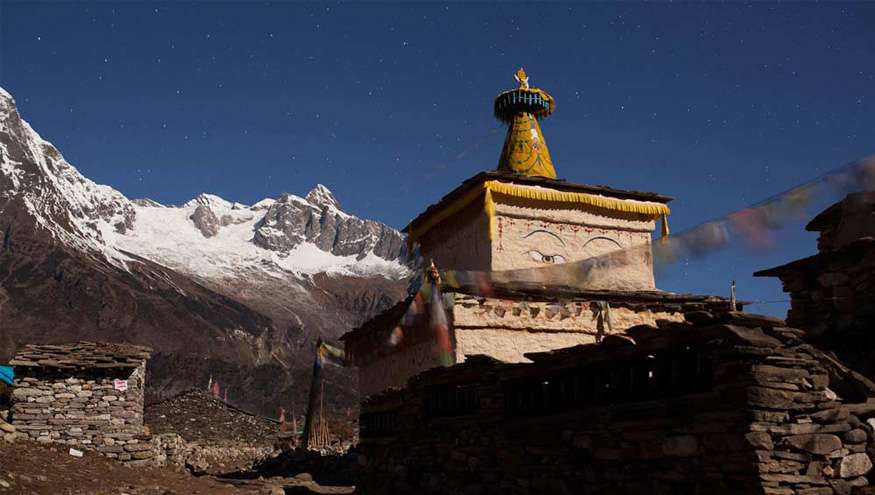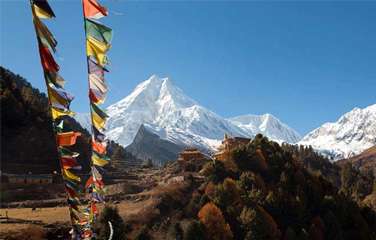Useful Information
Tsum Valley Trek route
Tsum Valley Trekking begins with a drive from Kathmandu to Soti Khola. From here, you begin trekking towards Machha Khola. The trail passes through lush forests and small villages like Jagat, Philim, Chumling, and Chokangparo to take you to the Nile. Here, you visit Milarepa Piren Phu Cave and gradually ascend to Mu Gompa, the highest point of the trek. Further, the trail passes by Rachen Gompa, Dumje, Philim, and Tatopani. You reach back to Soti Khola and drive back to Kathmandu that marks the end of the trip.
Tsum Valley Trek map
Tsum Valley Trek map will present you with a picturesque overview of the trail that you will be following during the trek. The map is designed following our Tsum Valley Trek itinerary, therefore if you custom made the itinerary, the map will also change. You can see all the major villages and highlights marked on the map.
Tsum Valley Trek difficulty & Altitude Sickness
Tsum Valley Trek 18 Days is a moderate trek that requires 6 to 8 hours of walk each day. The trail is rugged, steep, and involves trodden parts at some places. Previous trekking experience with little technical climbing knowledge is needed to go on Tsum Valley Trekking. Likewise, you have to be in good health along with strong physical fitness and endurance to join this adventurous trip. There can be the risk of altitude sickness during this trek, however with our professionally designed itinerary including ample rest days and attention towards our guests makes the journey smooth.
Best time to go on Tsum Valley Trek
The best time to go on Tsum Valley Trek is during spring (March to April) and autumn (October to November). These are the ideal months to go on trekking in the Manaslu region because of stable weather, clear sky, and moderate climate. Likewise, monsoon (June to August) and winter (December to February) is not a good time to go on Tsum Valley Trekking because of the slippery trail and unclear views.
Accommodation & Meals
Tsum Valley Trekking is a teahouse trek. The services in this part of the Himalayas are very basic as only a handful of travelers visit this region. Teahouse offers small rooms with double beds and a shared washroom usually. The rooms can get cold during the night, therefore a nice sleeping bag is recommended to carry along the trek.
Meals will be served as per the menu of the teahouse. The Tsum Valley Trek package includes three meals a day. The menu mostly includes Nepali, Tibetan, Continental, and Indian dishes. Dishes like dhal, bhat & tarkari, momo, soup, toasts, cornflakes, pudding, pie, pasta, meat, egg, tenduk, etc are available.
Communication & Electricity
On Tsum Valley Trek 18 Days, you can find internet service at some lodges mostly in the villages in lower elevation. Likewise, the cellular network can be found at some places until a certain altitude. After reaching a high altitude, your team leader will contact the management office in the city using a satellite phone to report the day and the team members. For better service, we suggest you carry a local SIM Card that we can provide you on your request. You can get electricity to charge your batteries throughout the Tsum Valley Trek, however you may have to pay a few bucks. You can see both hydroelectricity and solar power in the villages.
Travel Insurance
Travel insurance is must to have to join Tsum Valley Trekking. As Tsum Valley Trek is a high altitude trek in the remote Himalayan region, there can be many unforeseen events. Therefore, having travel insurance will always have your back in an emergency. Your travel insurance must include air evacuation and hospital bills. Other things like flight cancellation and loss or theft of property are also advised to have in the insurance.
Guide & Porter
During the Tsum Valley Trek, you will be guided by our experienced and professional guide who has already mapped the Tsum Valley before and led many groups successfully. Likewise, you also get accompanied by porters. Our guides are well-trained and certified under several categories from first aid to rock climbing that ensures your safety during the trip.
Environmental Contribution
To protect the fragile Himalayan environment, we have been running sustainable and eco-friendly tours. Our itineraries are designed considering exo-tourism. Likewise, we also run a small organization that provides education to children from marginal mountain families. While traveling with us, you will be contributing immensely to support sustainable travel and locals' lives.



